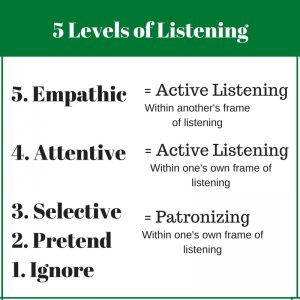Read Your Audience Know How
They Listen to You
(As seen at BizCatalyst 360) – As a small business owner, I am always in sales and marketing mode. Maybe you can relate. I also consistently work to improve my sales skills because that’s what keeps my business thriving. Recently, I learned that an aspect of listening both my own and my audience’s plays a key role in my effectiveness.
Last week, I listened to a workshop by J.T. Foxx, speaker and real estate mogul, on being successful at sales. He confirmed that the way I prepare for a sales presentation is right on track.
When selling, either to an individual customer, a committee or to an entire audience I hone my message to get my points across, to persuade and ultimately, to close the deal.
Foxx confirmed that the art of persuasion requires us to listen to our prospects. Our goal is to uncover their pain points and driving concerns. The highest grossing salespeople are successful because they listen to discover what their customers need. They are experts at communicating how their product or service will best satisfy those needs.
“Seek first to understand.” – Stephen R. Covey
The Missing Link
And then, came the puzzle piece that was my “aha” moment. Foxx said that as speakers, presenters, and sales people, the key to being effective is being able to “read” your audience. This means, being able to determine what level of listening they are practicing as you speak. The better you become at reading your audience, the more effective you will be at producing results. Some of us can do this naturally. Even so, distinguishing the practice and what it takes kicks it up a notch.
Reading Your Audience – How They Listen
Foxx trotted out Stephen R. Covey’s, 5 Levels of Listening, from the best-selling “Seven Habits of Highly Effective People.” The ideal, of course, is that everyone will actively listen. The reality is, each member of your audience will be listening from one of these five levels.
When you can “read” how your audience is listening, you can speak to that listening and have what you say make the difference.
The empathic and active listeners (levels 5 and 4) are focused on what you have to say. These are the people most open to new information and new ideas. Empathic listening, according to Covey, is where true communication occurs. Your Attentive Listener is focused but will listen through their own filter or lens.
Your selective listeners are listening for what they already know, or to see if you agree with them, or if they think you know what you’re talking about or not.
Pretend listeners can be tough to spot. They look like they’re listening to you, but they’re not. You have to be very observant to spot them. When someone is simply ignoring you, you almost always know it. Both of these listening levels are had to pierce through, but it can be done.
Learning to Read Your Audience
You can begin to sharpen your ability to read your audience every single day, with every single interaction you have. The more quickly you recognize how someone is listening to you, the more effective you will be at persuasion, closing the deal, winning the sale, and inspiring people to take action.
Here are the aspects of each listening practice that will help you identify them more easily:

Level 5: Empathic Listening
Empathic listening is intentional. According to Covey, Level 5 is where true communication takes place. This is because the listener actively attempts to see things from the other person’s perspective or point of view, rather than with their own filter or lens. The person who develops this skill listens to both the other person’s words, and for what the words mean. They’re willing to give their time AND full attention to truly hear the other person.
Level 4: Attentive Listening
Attentive listeners offer their time and attention. But they are one step short of being empathic listeners because attentive listeners hear from their frame of reference. They don’t try to put themselves in the other person’s shoes.
Level 3: Selective Listening
Selective listening happens when the person you’re speaking with only listens for what they want to hear. Do you or don’t you agree with them? Are they right and are you wrong? Generally, they’re quick to interrupt or they have a tendency to finish the other person’s sentences.
Level 2: Pretend Listening
To truly hear someone takes time and attention. Pretend listeners give you the impression they hear what you’re saying, and they may actually hear some of your words, but they are not being “present.”
They may nod their head or offer another gesture to indicate they’re listening, but they don’t give you their full attention.
Level 1: Ignoring
We all know when we are being ignored. We talk but the other person doesn’t give any attention to what we are saying. It’s possible the person didn’t hear us. If you suspect that, check in and ask them.
For more on being an effective speaker, contact Susan Bender Phelps, MS Management & Organizational Leadership. Susan is a nationally recognized speaker, corporate trainer, and speaker’s coach. She is the author of the best-selling book, “Aspire Higher,” a collection of true career and business mentoring success stories. Susan inspires audiences to create breakthrough results in their lives and work. Learn more at www.SusanBenderPhelps.com, visit her on LinkedIn and follow her on Twitter at @OdysseyMentor.
